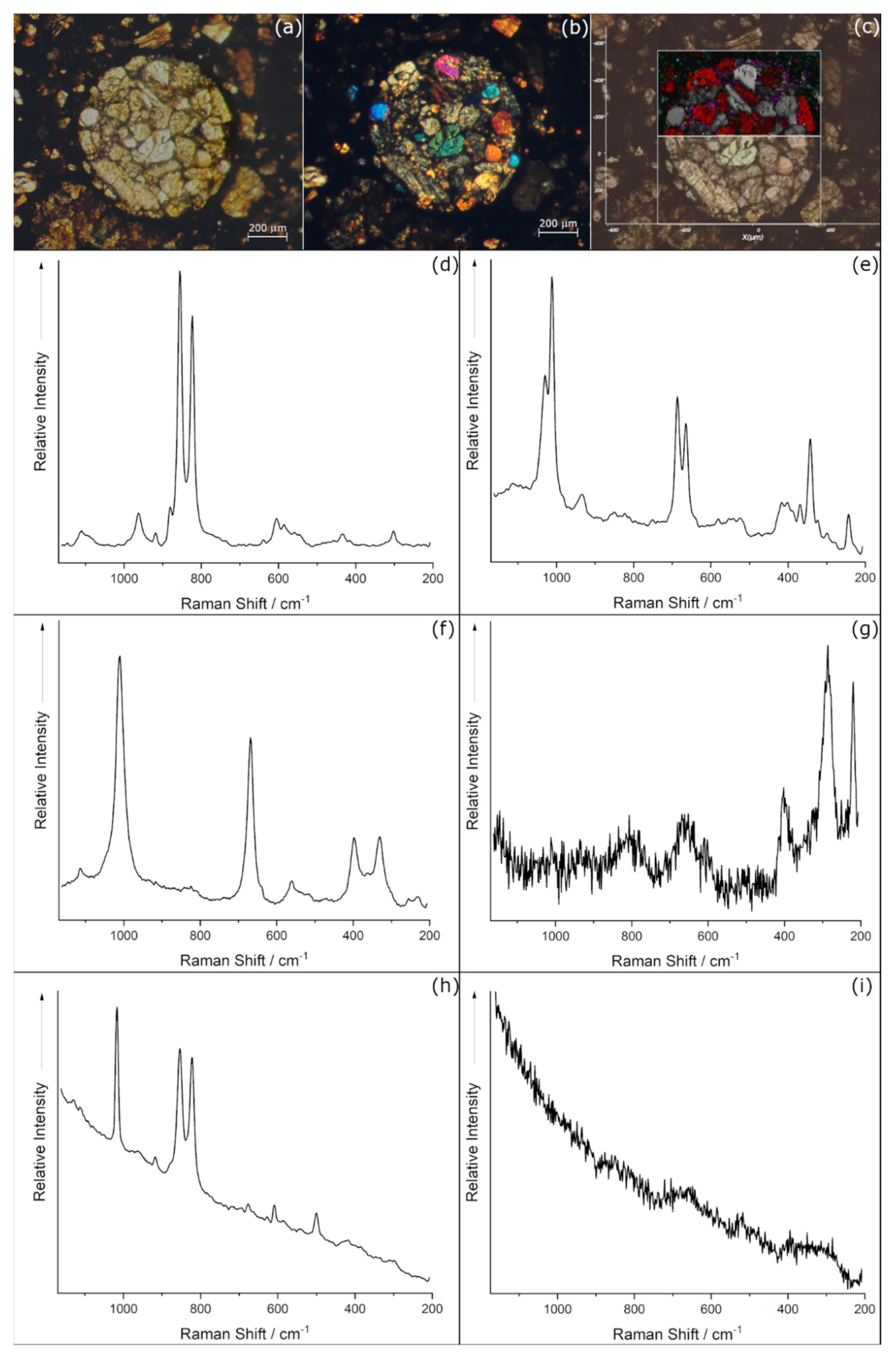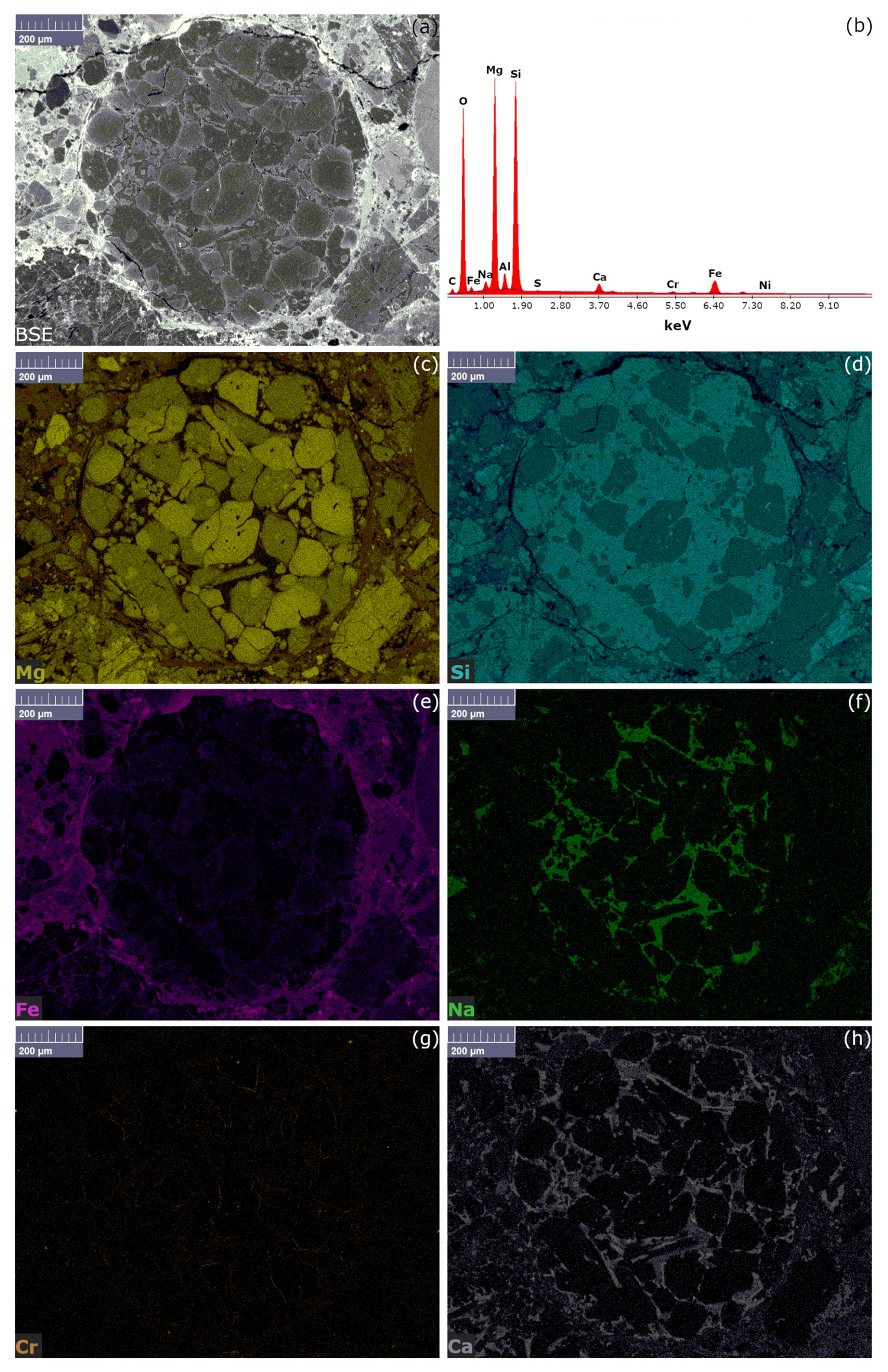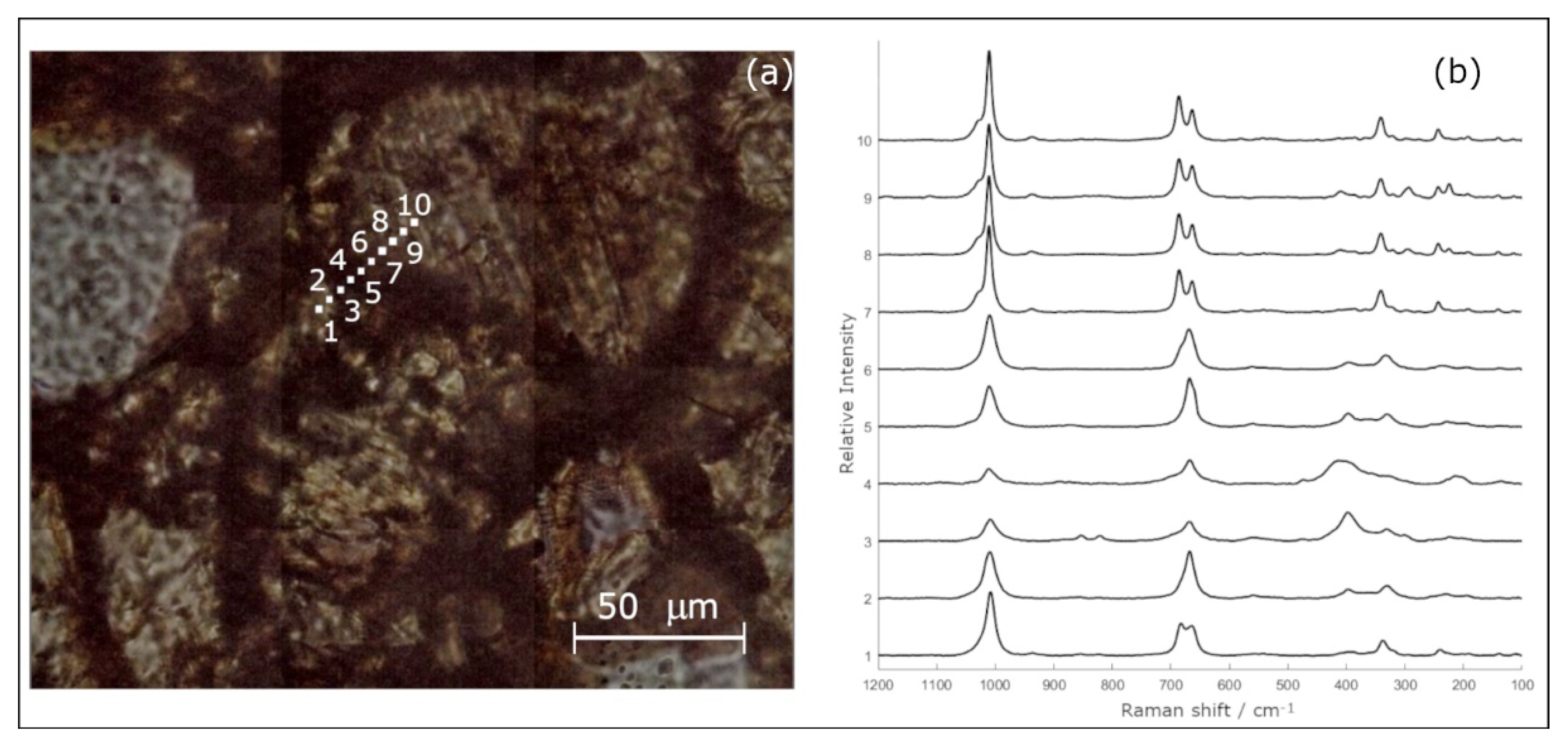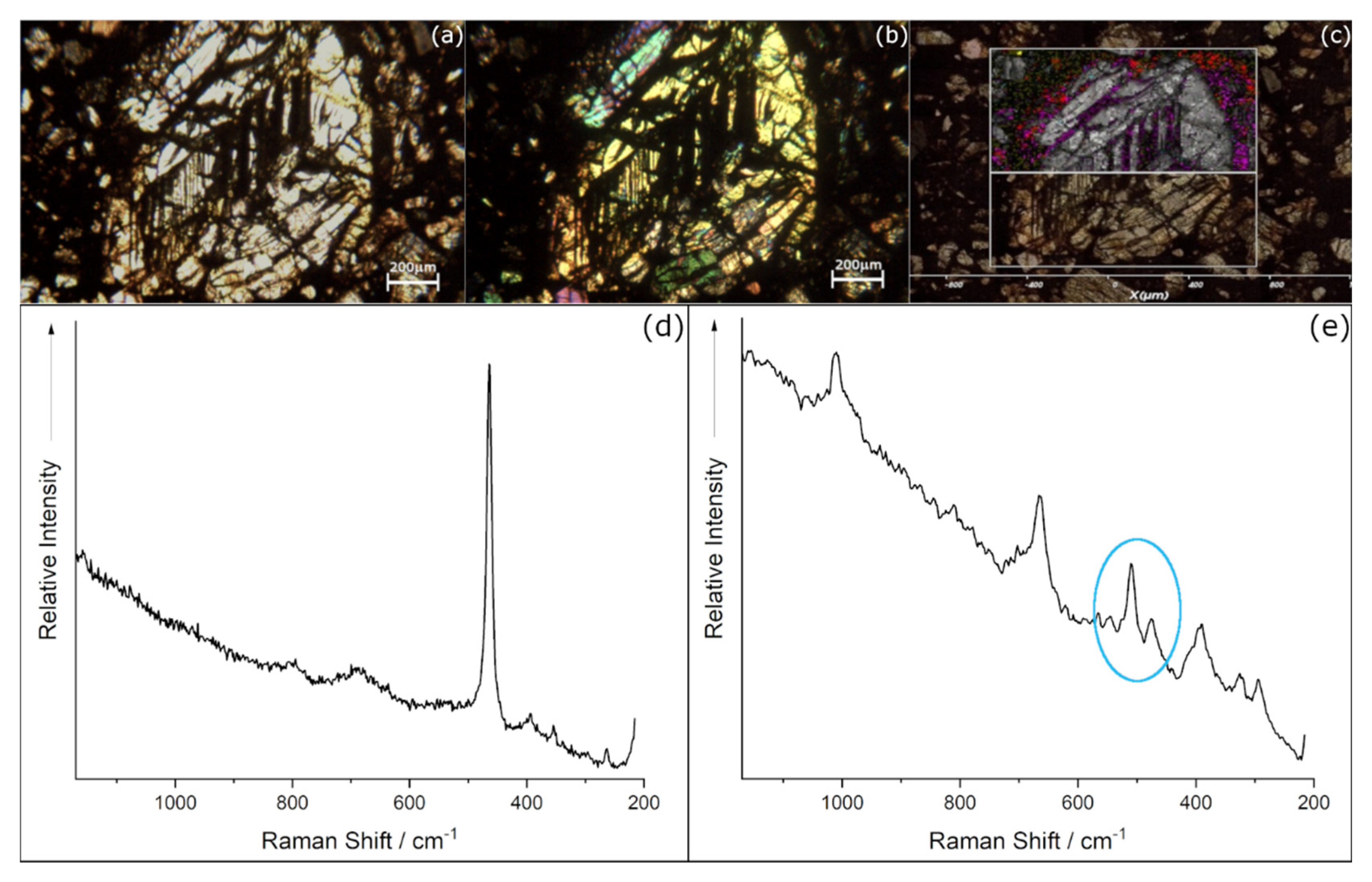Combining Micro-Raman Spectroscopy and Scanning Electron Microscopy Mapping: A Stony Meteorite Study
Abstract
1. Introduction
2. Materials and Methods
2.1. Material
2.2. Micro-Raman Spectroscopy
2.3. SEM-EDS
3. Results
3.1. Chondrule A
3.2. Chondrule B
4. Discussion
5. Conclusions
Author Contributions
Funding
Institutional Review Board Statement
Informed Consent Statement
Data Availability Statement
Acknowledgments
Conflicts of Interest
References
- Tsuchiyama, A.; Uesugi, M.; Matsushima, T.; Michikami, T.; Kadono, T.; Nakamura, T.; Uesugi, K.; Nakano, T.; Sandfors, S.A.; Noguchi, R. Three-Dimensional Structure of Hayabusa Samples: Origin and Evolution of Itokawa Regolith. Science 2011, 333, 1125–1128. [Google Scholar] [CrossRef]
- Bonali, L.; Brunetto, R.; Beck, P.; Dartois, E.; Dionnet, Z.; Djouad, Z.; Duprat, J.; Furi, E.; Kakazu, Y.; Montagnac, G.; et al. Visible-IR and Raman microspectroscopic investigation of three Itokawa particles collected by Hayabusa: Mineralogy and degree of space weathering based on nondestructive analyses. Meteorit. Planet. Sci. 2015, 50, 1562–1576. [Google Scholar] [CrossRef]
- Anders, E.; Grevesse, N. Abundances of the elements: Meteoritic and solar. Geochim. Cosmchim. Acta 1989, 53, 197–214. [Google Scholar] [CrossRef]
- Bouvier, A.; Vervoort, J.D.; Jonathan Patchett, P. The Lu–Hf and Sm–Nd isotopic composition of CHUR: Constraints from unequilibrated chondrites and implications for the bulk composition of terrestrial planets. Earth Planet. Sci. Lett. 2008, 273, 48–57. [Google Scholar] [CrossRef]
- Hoffmann, B.A. Meteorites: Messengers from the Early Solar System. Chimia 2010, 64, 736–740. [Google Scholar] [CrossRef][Green Version]
- Weisberg, M.K.; McCoy, T.J.; Krot, A.N. Systematics and Evaluation of Meteorite Classification. In Meteorites and the Early Solar System II; Lauretta, D.S., McSween, H.Y., Eds.; The University of Arizona Press: Tucson, AZ, USA; Lunar and Planetary Institute: Houston, TX, Texas, 2006; Part I; pp. 19–52. [Google Scholar]
- Van Schmus, W.R.; Wood, J.A. A chemical-petrologic classification for the chondritic meteorites. Geochim. Cosmchim. Acta 1967, 31, 747–765. [Google Scholar] [CrossRef]
- Meteoritical Society. Available online: https://meteoritical.org/ (accessed on 5 November 2021).
- Fries, M.; Steele, A. Raman spectroscopy and confocal raman imaging in mineralogy and petrography. In Springer Series in Surface Sciences; Dieing, T., Hollricher, O., Toporski, J., Eds.; Springer: Berlin/Heidelberg, Germany; Dordrecht, The Netherlands; London, UK; New York, NY, USA, 2010; Volume 6, pp. 111–136. [Google Scholar]
- Rinaudo, C.; Belluso, E.; Gastaldi, D. Assessment of the use of Raman spectroscopy for the determination of amphibole asbestos. Min. Mag. 2004, 68, 455–465. [Google Scholar] [CrossRef]
- Wang, W.; Scarratt, K.; Emmett, J.L.; Breeding, C.M.; Douthit, T.R. The effects of heat treatment on Zircon inclusions in Madagascar Sapphire. Gems Gemol. 2006, 3, 134–150. [Google Scholar] [CrossRef]
- Michel-Levy, M.C.; Lautie, A. Microanalysis by Raman spectroscopy of carbon in chondrites. Meteoritics 1981, 16, 301–302. [Google Scholar] [CrossRef]
- Wopenka, B.; Sandford, S.A. Laser Raman microprobe study of mineral phases in meteorites. Meteoritics 1984, 19, 340–341. [Google Scholar]
- Heymann, D. Raman spectra of carbon in the Canyon Diablo iron meteorite (abstract). In Proceedings of the 18th Lunar and Planetary Science Conference, Houston, TX, USA, 16–20 March 1987; pp. 419–420. [Google Scholar]
- Wang, A.; Jolliff, B.L.; Haskin, L.A. Raman spectroscopic characterization of a Martian SNC meteorite Zagami. J. Geophys. Res. 1999, 104, 8509–8519. [Google Scholar] [CrossRef]
- El Amri, C.; Maurel, M.C.; Sagon, G.; Baron, M.H. The micro-distribution of carbonaceous matter in the Murchison meteorite as investigated by Raman imaging. Spectrochim. Acta A 2005, 61, 2049–2056. [Google Scholar] [CrossRef]
- Steele, A.; Fries, M.D.; Amundsen, H.E.F.; Mysen, B.O.; Fogel, M.L.; Schweizer, M.; Boctor, N.Z. Comprehensive imaging and Raman spectroscopy of carbonate globules from Martian meteorite ALH 84001 and a terrestrial analogue from Svalbard. Meteorit. Planet. Sci. 2007, 42, 1549–1566. [Google Scholar] [CrossRef]
- Wang, A.; Korotev, R.L.; Jolliff, B.L.; Ling, Z. Raman imaging of extraterrestrial materials. Planet. Space Sci. 2015, 112, 23–34. [Google Scholar] [CrossRef]
- Kaeter, D.; Ziemann, M.A.; Botteger, U.; Weber, I.; Hecht, L.; Voropaev, S.A.; Korochantsev, A.V.; Kocherov, A.V. The Chelyabinsk meteorite: New insights from a comprehensive electron microscopy and Raman spectroscopy study with evidence for graphite in olivine of ordinary chondrites. Meteorit. Planet. Sci. 2018, 53, 416–432. [Google Scholar] [CrossRef]
- Cao, H.; Chen, J.; Fu, X.; Xin, Y.; Qi, X.; Shi, E.; Ling, Z. Raman spectroscopic and geochemical studies of primary and secondary minerals in Martian meteorite Northwest Africa 10720. J. Raman Spectrosc. Sci. 2021, 1–15. [Google Scholar] [CrossRef]
- Tomkins, A.G.; Johnson, T.E.; Mitchell, J.T. A review of the chondrite–achondrite transition, and a metamorphic facies series for equilibrated primitive stony meteorites. Meteorit. Planet. Sci. 2020, 55, 857–885. [Google Scholar] [CrossRef]
- Rinaudo, C.; Croce, A.; Musa, M.; Fornero, E.; Allegrina, M.; Trivero, P.; Bellis, D.; Sferch, D.; Toffalorio, F.; Veronesi, G.; et al. Study of Inorganic Particles, Fibers, and Asbestos Bodies by Variable Pressure Scanning Electron Microscopy with Annexed Energy Dispersive Spectroscopy and Micro-Raman Spectroscopy in Thin Sections of Lung and Pleural Plaque. Appl. Spectrosc. Sci. 2010, 64, 571–577. [Google Scholar] [CrossRef] [PubMed]
- Reed, F.S.; Mergner, J.L. Preparation of rock thin sections. Am. Miner. 1953, 38, 1182–1203. [Google Scholar]
- MacKenzie, W.S.; Adams, A.E.; Brodie, K.H. Minerals. In Rock & Minerals in Thin Section, 2nd ed.; Taylor and Francis Group: Abingdon, UK, 2017. [Google Scholar]
- Grady, M.; Pratesi, G.; Moggi-Cecchi, V. Ordinary Chondrite. In Atlas of Meteorite; Cambridge University Press: Cambridge, UK, 2014; pp. 71–167. [Google Scholar]
- Shubnel, H.J.; Pinet, M.; Smith, D.C.; Lasnier, B. Spectres Raman des principales gemmes. In La Microsonde Raman en Gemmologie; Ruskoné, E., Ed.; Association Francaise de Gemmologie: Paris, France, 1992; pp. 18–54. [Google Scholar]
- Huang, E.; Chen, C.H.; Huang, T.; Lin, E.H.; Xu, J.-A. Raman spectroscopic characteristics of Mg-Fe-Ca pyroxenes. Am. Miner. 2000, 85, 473–479. [Google Scholar] [CrossRef]
- Wang, A.; Kuebler, K.E.; Jolliff, B.L.; Haskin, L.A. Raman spectroscopy of Fe-Ti-Cr-oxides, case study: Martian meteorite EETA79001. Am. Miner. 2004, 89, 665–680. [Google Scholar] [CrossRef]
- Prieto-Taboada, N.; Gómez-Laserna, O.; Martínez-Arkarazo, I.; Olazabal, M.A.; Madariaga, J.M. Raman Spectra of the Different Phases in the CaSO4–H2O System. Anal. Chem. 2014, 86, 10131–10137. [Google Scholar] [CrossRef]
- Freeman, J.J.; Wang, A.; Kuebler, K.E.; Jolliff, B.L.; Haskin, L.A. Characterzation of Natural Feldspars by Raman Spectroscopy for future planetary exploration. Can. Miner. 2008, 46, 1795–1818. [Google Scholar] [CrossRef]
- Feng, L.; Lin, Y.; Hu, S.; Xu, L.; Miao, B. Estimating compositions of natural ringwoodite in the heavily shocked Grove Mountains 052049 meteorite from Raman spectra. Am. Miner. 2011, 96, 1480–1489. [Google Scholar] [CrossRef]
- Avril, C.; Malavergne, V.; Caracas, R.; Zanda, B.; Reynard, B.; Charon, E.; Bobocioiu, E.; Brunet, F.; Borensztajn, S.; Pont, S.; et al. Raman spectroscopic properties and Raman identification of CaS-MgS-MnS-FeS-Cr2FeS4 sulfides in meteorites and reduced sulfur-rich systems. Meteorit. Planet. Sci. 2013, 48, 1415–1426. [Google Scholar] [CrossRef]
- Gooding, J.; Keil, K. Relative abundances of chondrule primary textural types in Ordinary Chondrites and their bearing on conditions of chondrule formation. Meteoritics 1981, 16, 17–43. [Google Scholar] [CrossRef]
- McSween, H.Y. Petrographic variations among carbonaceous chondrites of the Vigarano type. Geochim. Cosmochim. Acta 1977, 44, 477–491. [Google Scholar] [CrossRef]
- Deer, W.A.; Howie, R.A.; Zussman, J. An Introduction to the Rock-Forming Minerals, 2nd ed.; Longman Group UK Limited: London, UK, 1992. [Google Scholar]
- Bridges, J.C.; Grady, M.M. A halite-siderite-anhydrite-chlorapatite assemblage in Nakhla: Mineralogical evidence for evaporites on Mars. Meteorit. Planet. Sci. 1999, 34, 407–415. [Google Scholar] [CrossRef]
- Vaniman, D.T.; Martínez, G.M.; Rampe, E.B.; Bristow, T.F.; Blake, D.F.; Yen, A.S.; Ming, D.W.; Rapin, W.; Meslin, P.Y.; Morookian, A.M.; et al. Gypsum, bassanite, and anhydrite at Gale crater, Mars. Am. Miner. 2018, 103, 1011–1020. [Google Scholar] [CrossRef]
- Ling, Z.; Wang, A. Spatial distributions of secondary minerals in the Martian meteorite MIL 03346,168 determined by Raman spectroscopic imaging. J. Geophys. Res. Planets 2015, 120, 1141–1159. [Google Scholar] [CrossRef]
- Scott, R.D. Origin of rapidly solidified metal-troilite grains in chondrites and iron meteorites. Geochim. Cosmochim. Acta. 1982, 46, 813–823. [Google Scholar] [CrossRef]
- De Faria, D.L.A.; Venâncio Silva, S.; De Oliveira, S.M.T. Raman microspectroscopy of some iron oxides and oxyhydroxides. J. Raman Spectrosc. Sci. 1997, 28, 873–878. [Google Scholar] [CrossRef]
- Leroux, H.; Cordier, P. Magmatic cristobalite and quartz in the NWA 856 Martian meteorite. Meteorit. Planet. Sci. 2006, 41, 913–923. [Google Scholar] [CrossRef]
- Weisberg, M.K.; Kimura, M.; Suzuki, A.; Ohtani, E.; Sugiura, N. Discovery of Coesite and Significance of High Pressure Phases in the Gujba CB Chondrite. In Proceedings of the 37th Annual Lunar and Planetary Science Conference, Houston, TX, USA, 13–17 March 2006. [Google Scholar]
- Rodgers, K.A.; Hampton, W.A. Laser Raman identification of silica phases comprising microtextural components of sinters. Mineral. Mag. 2003, 67, 1–13. [Google Scholar] [CrossRef]
- Schmidt, P.; Bellot-Gurlet, L.; Léa, V.; Sciau, P. Moganite detection in silica rocks using Raman and infrared spectroscopy. Eur. J. Miner. 2013, 25, 797–805. [Google Scholar] [CrossRef]






Publisher’s Note: MDPI stays neutral with regard to jurisdictional claims in published maps and institutional affiliations. |
© 2021 by the authors. Licensee MDPI, Basel, Switzerland. This article is an open access article distributed under the terms and conditions of the Creative Commons Attribution (CC BY) license (https://creativecommons.org/licenses/by/4.0/).
Share and Cite
Musa, M.; Rossini, R.; Di Martino, D.; Riccardi, M.P.; Clemenza, M.; Gorini, G. Combining Micro-Raman Spectroscopy and Scanning Electron Microscopy Mapping: A Stony Meteorite Study. Materials 2021, 14, 7585. https://doi.org/10.3390/ma14247585
Musa M, Rossini R, Di Martino D, Riccardi MP, Clemenza M, Gorini G. Combining Micro-Raman Spectroscopy and Scanning Electron Microscopy Mapping: A Stony Meteorite Study. Materials. 2021; 14(24):7585. https://doi.org/10.3390/ma14247585
Chicago/Turabian StyleMusa, Maya, Riccardo Rossini, Daniela Di Martino, Maria Pia Riccardi, Massimiliano Clemenza, and Giuseppe Gorini. 2021. "Combining Micro-Raman Spectroscopy and Scanning Electron Microscopy Mapping: A Stony Meteorite Study" Materials 14, no. 24: 7585. https://doi.org/10.3390/ma14247585
APA StyleMusa, M., Rossini, R., Di Martino, D., Riccardi, M. P., Clemenza, M., & Gorini, G. (2021). Combining Micro-Raman Spectroscopy and Scanning Electron Microscopy Mapping: A Stony Meteorite Study. Materials, 14(24), 7585. https://doi.org/10.3390/ma14247585









